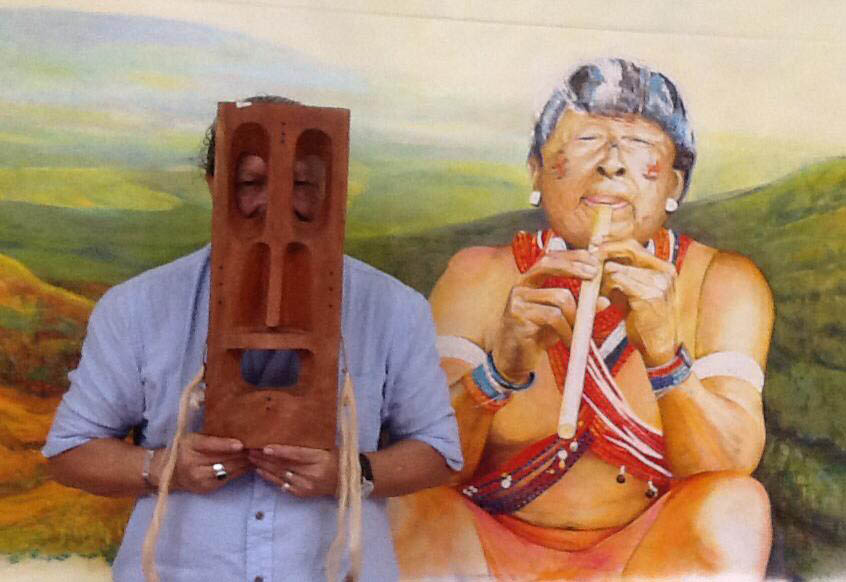 At the end of May, the subject of Guyanese art as a label, concept, movement, or school was revisited. The focus was an identification of the characteristics of pre-independence and post-independence art and Philip Moore and Stanley Greaves – two of the most outstanding and influential Guyanese artists – were referred to as exemplars of painting and sculpture that showed how the work of individual artists could stand out to represent national art.
At the end of May, the subject of Guyanese art as a label, concept, movement, or school was revisited. The focus was an identification of the characteristics of pre-independence and post-independence art and Philip Moore and Stanley Greaves – two of the most outstanding and influential Guyanese artists – were referred to as exemplars of painting and sculpture that showed how the work of individual artists could stand out to represent national art.
While it was not difficult to place some of the art, including that of E R Burrowes, as pre-independence, others such as those of Greaves, Moore, Ron Savory and Aubrey Williams, defy time divisions, and while standing out among certain trends before independence, have a strong presence that developed since 2000.
In fact, Greaves is one of the main artists whose powerful resurgence, that is, important new phases, changes and fresh preoccupations in paintings stand out. Bernadette Persaud is another. But yet another who stood out extraordinarily in this category was George Simon, a great Guyanese artist whose work represented post-independence developments.

George Simon (1947 – 2020) was a painter, archaeologist, researcher, former lecturer, and coordinator at the University of Guyana (UG), Anthony Sabga Awards laureate, and former tutor at the Burrowes School of Art. A lecturer in the Division of Creative Arts as well as coordinator and researcher in the Amerindian Research Unit in the Faculty of Education and Humanities at UG, he was also an instructor and organiser for developing artists in St Cuthbert’s Mission. In that capacity, he was responsible for the emergence of the Lokono Artists group that originated in the mission and went on to be known as the Moving Circle of Artists.
As an anthropologist and archaeologist, Simon was formally trained in England. He returned to Guyana and worked on several projects with Denis Williams, mapping the archaeology of Guyana and the Amazon Shield. He also worked on projects with the Walter Roth Museum of Anthropology and Archaeology. Most recently, he was part of a team working on the mounds discovered up the Berbice River, a project led by Neil Whitehead in collaboration with UG.
It was his exceptional achievements in art, backed up by his anthropology and archaeology, that won him the Anthony Sabga Caribbean Award for Excellence in the category of Arts and Letters. Simon had advanced to become one of Guyana’s foremost artists and among the most outstanding in the Caribbean, particularly in the area of Amerindian art which he helped tremendously to move forward.
He was extraordinary for his own styles and preoccupations in the area of Amerindian art and his originality, peculiarity, and individuality grew as the years progressed. He led the rise of Amerindian art, which grew rapidly to become a major force post-Independence. Simon’s art underwent at least two or three new beginnings, or advancements in the 1990s and after 2000, as if he were growing better, more interesting, and more complex with age. Simon’s experience, research and widening interests since 2000 certainly contributed to the advancing importance of his paintings in contemporary Guyanese art.
Present in the pre-Colombian era, right through colonial history in the 19th and first half of the 20th centuries, Amerindian art included rock paintings, rock drawings, and petroglyphs of the indigenous people. However, it had declined during colonialism from its strong indigenous traditions to the passivity executed by colonial artists. In this era, the people were reduced to subjects in that sketches were made of them, along with realistic drawings and later paintings of landscape, people, and villages. The interests of European artists ranged from exoticism to documentation in which the art was done to support anthropological studies and records for the archives.
Artists were employed by anthropologists, botanists and other researchers visiting Guyana and several drawings and watercolours have been preserved. Examples of this may be found in the work of Edward Goodall who accompanied Sir Robert Schomburgk’s famous expedition to British Guiana in 1841 – 1843. Prof Mary Noel Menezes published his work in Sketches of Amerindian Tribes 1841-1843.
Pre-Independence Amerindian art began to deepen in the second half of the 20th century with Guyanese artists exploring the ethnic ethos and identifying with the motifs and spiritual symbols. Among these were Marjorie Broodhagen and Stephanie Correia. This aspect of the art was studied by Aubrey Williams who advanced it internationally.
A great leap forward was taken in the 1980s with the rise of Simon and the discovery of sculptor Oswald Hussein, his brother. The group of Lokono artists, who were taught by Simon in his native St Cuthbert’s Mission, exploded on the world with the exhibition titled “Six Lokono Artists.” It announced the resurgence of Amerindian art, bringing it to the forefront. As a result, it claimed an emphatic place in national consciousness.
It was here that the deep preoccupations among these artists with the animism and folklore described by Walter Roth was visible. Sculptors, painters, and carvers of totem poles exhibited the traditions of spiritual beliefs that expressed themselves in the art. These included the rainforests with its peculiar environment and its inhabitants, both hunters and animals, including mysterious birds, caimans, serpents, and jaguars in an expression of the animism and the mythical beliefs associated with them. Strong representations of these came from Hussein, Lynus Klenkian, and Winslow Craig, who is not an Arawak, but who inhabits this cosmic space, although it is not his main focus. Klenkian, one of the Arawaks, has even narrated how he gained empathy with the animals and the landscape and how his spiritual immersion even extended to the wood he selected for his sculpture.
Simon not only kept pace with these developments, but led the rise of this art. One of his imposing canvases in the 1980s was of a hunter with a bow and arrow spearing fish in the river against a dominant red background. This type of work was to acquire greater depth from the 1990s into the 21st century, when more of the spiritual traditions and mythology were integrated into not just the depiction of subject matter, but of theme, symbolism, and the evolution of style, technique, and concept. Simon has delved into the grotesque as a particularly significant corner of the imagination befitting the world of the rainforest with its hunters, animals, vegetation, especially tree roots, and its spirits.
The kanaima is a creature of that environment, well known as a shapeshifter with super-human powers, and the ability to blend with the forest, imitate its sounds, practice ventriloquism, and transmigrate into the form of its animals. The jaguar is the main form assumed by kanaima and Simon represents this in several works. But even when jaguars do not appear, Simon’s painting techniques encompass the shape-shifting characteristic, and by the spots and the presence of the animal.
Once Simon painted a nude model, but she ended up as a medium for mythology, animism, spiritual presence, and grotesque landscape. The omnipresence of jaguars and spots and the merging and shifting of forms and shapes characterise the painting. It seemed the piece was imitating its subjects, or the model and the painter’s devices were possessed by the spiritual traditions. He was also known to interrogate other mythologies and bring into paintings the snake symbols of Haiti. These he merged with the Guyanese water mama – the ‘fair maid’ of the river.
That phase of Simon’s art was strongly manifested in a few murals and pieces of public art that he produced as a project for Carifesta X hosted in Guyana in 2008. There was a colourful and mesmerising triptych that once ennobled the foyer of the National Cultural Centre. But none outstrips the mural at the entrance to the Arts faculty building on the Turkeyen Campus at UG, the “Palace of the Peacock – Homage to Wilson Harris” painted by Simon, Philbert Gajadhar and Anil Roberts in 2009.
The same techniques are in evidence, although the styles of the other artists merge very well. They all pay tribute to Harris’s own form of writing and concept, which engage magical realism as well as abstraction. The eyes of the peacock’s flaring tail intersperse with the spots of the jaguar and the leaves of the rainforest. It is further example of the intertextual nature of Guyanese art, and brings to mind Greaves’ interrelations with Martin Carter, Wilson Harris, and Edgar Mittelholzer (as in the exhibition “Shadows Move Among Them”) and Persaud’s engagement with Carter.
One of the most resounding rebirths in Simon’s art developed after his journey into shamanism. This was a spiritual quest into the depths of his own native traditions where the shaman ruled the society with his many powers, including those of astral travel and spiritual transmigrations. Simon had long sojourns in other countries. These included Haiti, England, Chad, and Sudan. He immersed himself in those cultures and traditions and found factors valuable to the art that he created as a result. The most famous and most representative painting from those encounters is “The Shaman’s Journey Into the Milky Way”, which is in part autobiographical, in part expressive of his inward journeys into the mind, the imagination, and the geographical travels into various cultures. Simon explained that he based it on an indigenous myth. Yet the several paintings he produced contained the motifs of shamanism and of the Milky Way. These paintings, additionally, emerged at a time when there was intense concern for the natural environment.
Later paintings reverted to the landscape, but yet were interior in nature. Several invade the roots of trees and others used them as motifs. Even in his latest paintings, Simon’s imagination remained unfathomable. Ever original, his work expresses his preoccupations while advancing the frontiers of Amerindian art. Simon’s entire career developed in the post-Independence era. As a contemporary, he offered brave new formal explorations which, wild as they are, demonstrate very strong excursions into forms of modernist Guyanese art.









